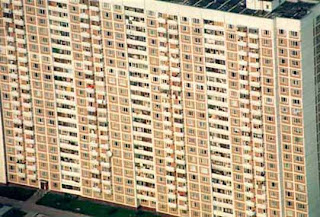Large apartment blocks are commonplace in Moscow. Most were built in the Stalin or post-Stalin era. They were built in response to the demand for non-communal housing where individual families could live in the privacy of their own apartments without having to share their livelihood with multiple other families in a dormitory-style residence.
A close up shot of one of these apartment blocks shows their density. From the outside, one would expect long corridors running through each floor of these structures with multiple exit routes. However, having lived inside one of these large blocks, I came to realize that their internal structures are quite different than what the exterior of these buildings would suggest.
Internally, these large blocks are subdivided into pods of a handful of apartments on each floor. In my apartment building there were four apartments to a pod, with each pod having access to two small elevators and a stairwell that led to a common exit on the ground floor. Subdividing these building into pods creates big safety issues for the apartments' inhabitants (subject of a future posting), but - as I have been told - these structures were engineered in this manner for a very particular purpose.
Individual apartments address the need of private living for each family. The size of these building structures creates housing efficiency. However, these two design factors do not explain the subdivisions, or pods, created on each floor. The design goal of these pods, as I have been plausibly explained to, was to create social isolation. In other words, these buildings were engineered with social engineering in mind. The goal of that social engineering was to prevent self-organization that would potentially lead to anti-government sentiments or movements.
Engineered Social Isolation, US Style: I Choose
Newly constructed buildings in Moscow have a more familiar Western design. Moscow's outskirts sport posh housing in gated communities; in this case, social isolation is voluntarily (as we sadly see in the US). Newer apartment buildings are designed so they sell more easily to the target markets.
The changing building architecture is reflective of how Russia's social architecture is changing - a welcomed and healthy change for all.




I wonder - do you know who mrs Baturina is and what she is doing to Moscow? :)
ReplyDelete